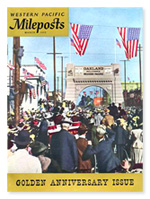
|
In March 1953 Western Pacific's company magazine, Mileposts,
published its Golden Anniversary Issue commemorating the fiftieth
year of Western Pacific's corporate existence (cover shown at left). The lead article
of that issue titled "Fifty Candles for
Western Pacific", written by the late Gilbert H. Kneiss, chronicled
the history of The Western Pacific Railroad Company, from the original
organizing meeting of March 3, 1903 down through the subsequent
fifty years.
The
final issue of Mileposts (March 1983 issue shown to the right) carried a reprint
of Gil Kneiss' article, "Fifty Candles for Western Pacific" as well
as R.W. "Dick" Bridges article "Eighty Candles on the Final Cake"
chronicling the final 30 years before
the merger with the Union Pacific. These two articles provide an accurate and fascinating account of the
Western Pacific from 1903 through the end in 1982, nearly 80 years
of WP history!
|
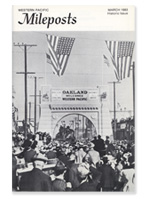
|
 Fifty
Candles for Western Pacific
Fifty
Candles for Western Pacific 
by
G.H. Kneiss
Tuesday,
March 3, 1903, was just another rainy day to most San Franciscans.
There wasn't much excitement. Carrie Nation, armed with axe and
Bible, smashed some bottled goods and glassware in a Montgomery
Street saloon and was hustled off to jail. To jail likewise went
Miss Flo Russell, a young lady whose crime lay in exposing an ankle
and bit of petticoat while lifting her skirts high enough to clear
the muddy pavement, and to jail in Marin County, across the Bay,
went one George Gow, who illegally failed to bring his automobile
to a dead stop when a horse-drawn vehicle approached within 300
feet.
Over
in Corea (as it then was spelled), San Franciscans learned from
their newspapers, fighting went on along the Yalu River between
the Russians and the Japanese, and at Harvard Professor Hollis,
chairman of the Athletic Committee, said that football aroused only
the worst impulses and should be abolished. Up in Sacramento Governor
Pardee signed a bill making the Golden Poppy the state flower of
California.
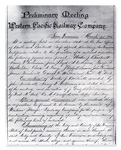
Preliminary meeting announcement
of the Western Pacific |
No,
not too much excitement, but even so readers of the San Francisco
Chronicle next day reached page 14 before they learned that eleven
men had sat down around a table in the Safe Deposit Building on
California Street and organized a new transcontinental railroad
to be named the Western Pacific.
It
was to run from the city of San Francisco eastward through the canyons
of the Feather River and Beckwourth Pass and on to Salt Lake City.
By branch lines it was also to serve San Jose, Alameda, Berkeley,
Richmond, Fresno, Chico and Prattville. Walter J. Bartnett, San
Francisco, lawyer and promoter, had subscribed to 14,900 of the
15,000 shares of capital stock but behind him, speculation went,
were probably the Goulds, the Vanderbilts, Jim Hill or David Moffat.
Perhaps
the reason that the Chronicle put its writeup back on page 14 along
with the truss ads and the electric belts was that the story was
not exactly new, Men had talked about a railroad through the Feather
River Canyon for a long time, particularly one named Arthur W. Keddie.
 KEDDIE'S
DREAM
KEDDIE'S
DREAM 
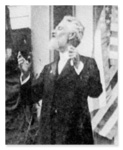
Arthur W. Keddie |
Keddie
had come to California in the early sixties - a young Scottish lad,
trained as a surveyor. By that time the gold diggers that had briefly
overrun the Feather River country following Bidwell's celebrated
discovery on July 4, 1848, had departed with their pokes and six-shooters.
Barkeeps and dance hall gals had followed them. The many-pronged
turbulent river which Arguello had named Rio de las Plumas because
of countless floating feathers from moulting wild pigeons, flowed
in solitude through its deep gorges.
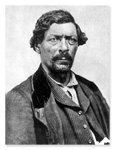
James P. Beckwourth |
One
of the first professional jobs that came Keddie's way after he had
hung out his shingle at Quincy, county seat of Plumas County, was
that of exploring the North Fork of the Feather for the newly-organized OroviIIe and Beckwourth Pass Wagon Road Company. Beckwourth
Pass, for unknown ages a great Indian thoroughfare, had been discovered
to civilization by Jim Beckwourth, a mulatto scout, in 1850. A Sierra
crossing more than 2,000 feet below the elevation of Donner Pass,
it had become popular for covered wagon trains.
Keddie
made his canyon reconnaissance in the dead of winter but the snows
he encountered were surprisingly light. Furthermore, he found a
route with grades too easy to waste on a wagon road. Back to Quincy
he went with a thrill and a dream in his heart - the thrill of having
discovered what he felt sure would prove to be the best route for
a transcontinental railway and the dream of having part in building
it.

Early Survey Team |
The
young surveyor managed to interest several important men in his
idea: Asbury Harpending of diamond hoax fame, Civil War General
William Rosecrans, Creed Hammond and others. Some of them were sincerely
interested in railroad building. Harpending, for one, was convinced
that the Central Pacific had chosen a most inferior route over the
mountains and would be easy competition. As the Quincy Union put
it: "The Central Pacific have long since understood they must content
themselves with the summer trade of Virginia City and Carson. The
Feather River Railroad will be the road across the continent." But
others of the associates were looking only at the speculative possibilities
when coupled with their own political influence.
The
Oroville and Virginia City Railroad Company was formed in April,
1867. Capital stock sales were authorized up to five million dollars,
but a negligible amount was sold. Where upon some of Keddie's new
associates railroaded a most amazing bill through the California
Legislature and induced Governor Haight to sign it.
This
new law was entitled "An Act Authorizing the Board of Supervisors
of Plumas County to take and Subscribe to the Capital Stock of the
Oroville and Virginia City Railroad Company." Actually, it not
only authorized them, it specified that said Supervisors could be
fined, removed from office, and sued for damages if they didn't
do so! This may have been good politics but it was deplorable public
relations. Enthusiasm for the railroad in Plumas County cooled while
indignation boiled and the Supervisors resigned en masse. A legal
battle finally repealed the obnoxious statute.
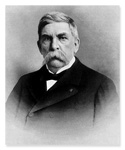
Grenville M. Dodge |
General
Rosecrans tried to induce the Union Pacific to take over the O.
& V. C. project as its California connection and thus by-pass
the Central Pacific with its already critical snow problems. His
old comrade in arms, General G. M. Dodge, actually left his U. P.
construction camp and came out to consider the offer. He liked what
he saw but the Central Pacific end-of-track was miles into the Nevada
sagebrush by then and, although the Union Pacific was authorized
by congress to build to the California line, it had to stop wherever
it met the C. P.
Keddie
started construction on the O. & V. C. near Oroville in the
spring of '69. A gang of thirty Chinese men was put to grading between
Thompson Flat and Morris Ravine. Shortly afterward Congress was
asked to help with a land grant of 641,200 acres. But the whole
thing blew up. The builders of the Central Pacific were adept at
"pressure" and they put plenty of it on Harpending to
ditch the scheme. And one of them, C.P. Huntington, laughed Keddie
out of his office with the remark "no man will ever be fool enough
to build a railroad through the Feather River Canyon." Arthur Keddie
had to put his dream in mothballs but he did not forget it. The
seventies and the eighties passed. The close of the latter decade
found the Union Pacific, less than entirely happy with its western
connection, again considering its own line to San Francisco. Out
in the field was Virgil G. Bogue, U. P. chief engineer, running
trial surveys over the Sierra. One was down the Pit River, one through
Susanville and along Deer Creek, several through Beckwourth Pass
and down the Feather. Bogue rather favored the Deer Creek route
despite some 80 miles of 4 per cent grade, but Jay Gould gained
control of the Union Pacific about that time, and the plans for
a San Francisco extension were abandoned.
 THE
SAN FRANCISCO & GREAT SALT LAKE
THE
SAN FRANCISCO & GREAT SALT LAKE 
This
was bad news to California shippers and merchants who had hoped
for some relief from the Central Pacific monopoly which skillfully
adjusted rates to the maximum figures which would allow its customers
to remain in business. A group of them got together and determined
to build the Union Pacific connection themselves. They incorporated
the San Francisco and Great Salt Lake Railroad Company and hired
Bogue's assistant, W. H. Kennedy. If he could locate a practicable
route, one which was not too expensive, they felt it should be possible
to find Eastern capitalists who would finance the undertaking.
Kennedy
was, of course, familiar with the surveys made by Union Pacific
but believed he might find an even better line. In Quincy he called
at the County Surveyor's office for a map of Plumas Country; the
County Surveyor was Arthur Keddie, and the two men found a lot to
talk about. Keddie told the engineer of the low pass he had found
near Spring Garden Ranch between the Middle Fork of the Feather
and Spanish Creek, a tributary of the North Fork. As the Middle
Fork Canyon became impossibly steep below this point and the North
Fork was almost as bad above it, this low divide offered a means
of utilizing the best parts of both canyons.
Crossing
the Sierra summit at Beckwourth Pass, thence descending the upper
reaches of the Middle Fork and cutting over to the North Fork at
Spring Garden, as Keddie had suggested, to reach the Sacramento
Valley at Oroville, Kennedy completed his survey late in 1892. It
was a good line, with a ruling grade of 1 1/3 per cent, and as he
filed his maps in the various county court houses, they established
under the existing laws, a five-year option on the route in the
name of the San Francisco and Great Salt Lake Railroad Company.
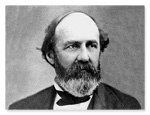
Collis Potter Huntington |
With
these rights and Kennedy's estimate of $35 million to build the
railroad, the San Franciscans journeyed to New York City, the lair
of capital. But everywhere the S.F.&G.S.L. promoters called,
they found Collis P. Huntington had been before them. Why spend
$35 million to compete with him, the wily old man had asked each
likely angel, he'd be glad to let them have the Central Pacific,
monopoly and all, for a good deal less and be glad to get it off
his hands. No one called his bluff and the San Francisco and Great
Salt Lake Railroad Company joined the other punctured bubbles.
 HARRIMAN
VS. GOULD
HARRIMAN
VS. GOULD 
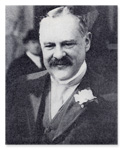
George J. Gould |
When
Jay Gould had acquired control of the Denver and Rio Grande properties,
he had seriously considered extending them to the Pacific Coast.
The Union Pacific, however, control of which he no longer owned,
had induced him not to. Both systems interchanged their westbound
traffic with the Central Pacific at Ogden and in return the latter
divided its eastbound loads equitably between them.
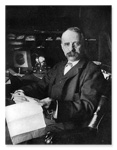
Edward H. Harriman |
But
when E. H. Harriman and his supporters, after acquiring the Union
Pacific, picked up control of the Southern Pacific System after
C. P. Huntington died in 1900, they closed the Overland Gateway
to the rival Rio Grande. George Gould, Jay's eldest son, had succeeded
to the 11,000-mile rail empire by then. It was his ambition to have
his own rails from coast to coast.They already stretched from Buffalo
to Ogden, he had definite plans to reach Baltimore, and he had hoped
to acquire the Central Pacific himself. Now, bottled up in Utah
by Harriman, he decided to build a new road to San Francisco.
Virgil
Bogue had become George Gould's consulting engineer and recalling
his surveys for the Union Pacific in the '80's, recommended Beckwourth
Pass and the Feather River route. Remembering also an unhappy experience
he had once had in locating any other road, only to find the whole
route plastered with mining claims of dubious mineral value but
through which rights of way must be negotiated, he advised Gould
to form a "mining company" first. Accordingly the North California
Mining Company was organized and soon nearly 600 placer claims were
staked out, blanketing the entire proposed route across the mountains.
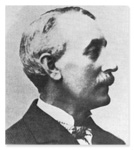
E. T. Jeffery |
Gould
turned the job over to the Denver and Rio Grande and its president,
E. T. Jeffery, sent a field party under H. H. Yard west to locate
the line. It was all top secret. The transit men and stake artists
were forbidden even to let their wives know where they were. Letters
could only be exchanged through the Denver office of the railroad.
Two California corporations, the Butte and Plumas Railway and the
Indian Valley Railway, were set up to be the figureheads.
It
was, however, more than a bit difficult to keep anything concerned
with a railroad through the Feather River Canyon secret from Arthur
Keddie. That was a subject he kept up with. Furthermore, he had
another railroad scheme on the fire himself. He had formed an alliance
with one Walter J. Bartnett who, with his associates, had built
a short line, the Alameda and San Joaquin Railroad only a few years
before from Stockton southwest to the Tesla coal mines. The mines
had not come up to expectations and Bartnett, who was an exceedingly
high powered promoter, had conceived the ambitious plan of extending
his 36-mile railroad east to Salt Lake City and west to San Francisco
and then selling it to the Goulds.
Bartnett
and Keddie incorporated the Stockton and Beckwith (sic) Pass Railroad
on December 1, 1902. Location was amazingly fast and simple. For
Keddie merely put some stooge "survey parties" out in the canyon
and as they haphazardly staked out each ten miles of "line," he
made a copy of the corresponding map Kennedy had filed in 1892 and,
by registering these in the county seats, won an incontestable
five-year franchise.
Walter
Bartnett then journeyed to New York with Keddie's franchise in his
pocket, convinced George Gould that it could not be ignored. Bartnett
and Gould signed an agreement on February 6, 1903, which provided
for the formation of a new company to take over the various corporations
which each had previously organized and to build and equip the railroad.
Less than a month later and pursuant to this pact, the meeting in
the Safe Deposit Building was called to order.
 THE
WESTERN PACIFIC IS BORN
THE
WESTERN PACIFIC IS BORN 
.
 |
The
Western Pacific Railway Company was thus organized on March 3, 1903.
Articles of Incorporation were filed with the County Clerk the same
day. But when Bartnett's clerk appeared next day at the Secretary
of State's office in Sacramento, the first of many roadblocks thrown
up by the Southern Pacific became apparent. For the pioneer railroad
between Sacramento and Oakland, completed way back in 1869, had
also been named Western Pacific and the S.P., which had taken it
over, still claimed all rights to the name. Bartnett threatened
mandamus proceedings and the S.P. withdrew its objections. The Western
Pacific Railway Company was thereupon incorporated, on March 6,
1903.
George
Gould still remained completely out of the picture and denied all
connection with the project. Although he financed the new surveying
parties that were immediately sent out to make the final location,
he was forced, in the interests of this secrecy, to keep the Rio
Grande engineers in the field as well. The absurd result was two
hostile groups struggling to outwit each other and often on the
point of exchanging pot shots, though both were actually on the
same payroll.
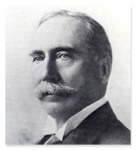
Virgil Bogue |
Virgil
Bogue was finally dispatched by Gould to choose the best of the
routes surveyed. One night, as he sat in his field tent pondering
the old Kennedy line with its grade of 1 1/3 per cent which the
Western Pacific engineers had accepted from Keddie, he noted from
the profiles that between Oroville and Beckwourth Pass there was
only a difference in elevation of 50 feet per mile. This suggested
to him the idea of a uniform one percent grade.
Rapid
investigation proved this feasible, and without climbing too high
above the river. Elated, Bogue wired E. T. Jeffery and with equal
enthusiasm the D&RG president answered that if a one per cent
grade railroad between San Francisco and Utah could be located, money
to build it was available regardless of the cost.
Shortly
thereafter General G. M. Dodge wrote to one of Bogue's associates
as follows:
I
am glad to see that you are out there on the Western Pacific. That
line is almost exactly the line I run (sic) south of Salt Lake,
thence down the Humboldt, across the Beckwourth Pass, and down the
Feather, but you have a better grade than I got. That is the line
the Union Pacific would have built if it had not been for the progress
of the Central Pacific east.
Rumors
were still thick as to who was behind the Western Pacific. Some
thought the Burlington interests. Others picked "Jim" Hill of the
Great Northern or David Moffat, the Colorado capitalist. Most felt
positive that Gould was behind the road despite his still positive
denials. There was a story current that Harriman and Ripley (of
the Santa Fe) had together offered him two million plus all he had
spent so far to give up the project. It was not until the spring
of 1905 that Gould publicly announced his paternity of the Western
Pacific and appointed President Jeffery of the Rio Grande to head
the new road as well. Bartnett, who had been president, became vice-president.
Contracts
for construction were signed late the same year, although the line
was not completely located nor the rights of way all secured. The
Southern Pacific naturally interposed every possible legal and physical
obstacle, but although it possessed immense political power and
a formidable bag of tricks, the Western Pacific promoters usually
managed to come out on top.
 WAR
ON THE WATERFRONT
WAR
ON THE WATERFRONT 

Horace Carpentier |
The
biggest row was that involving the WP ferry terminal on San Francisco
Bay. A little historical background is necessary here. Oakland was
an unnamed part of the Peralta rancho in 1851, when lawyer Horace
Carpentier and two associates made themselves at home on the oak-studded
meadows around what is now lower Broadway and started selling lots.
Don Vicente Peralta rode around with the sheriff when his cattle
began to disappear, but Carpentier glibly talked him into a lease
of the land on which he had squatted and then proceeded to incorporate
it as the City of Oakland. His hand-picked trustees gladly "sold"
him the entire 10,000 acre waterfront between high tide and the
ship channel for five dollars plus two per cent of any wharfage
fees he might collect. Carpentier then took office as mayor.
In
1868 when Central Pacific interests sought a terminal on the Bay
at Oakland, Carpentier made a nice deal with its management. The
Oakland Waterfront Company was incorporated for $5,000,000 by both
parties. Carpentier became its President and conveyed "all the waterfront
of the City of Oakland" to the new corporation. Through this succession
of events the Southern Pacific had maintained a stranglehold on
the Oakland waterfront for half a century, although the city had
several times attempted to invalidate the title.
Obviously
the S.P. was fully confident that it would have but little difficulty
in isolating the Western Pacific from a practical outlet on the
Bay. The Santa Fe, only a few years before, had built its ferry
slip way up at Point Richmond rather than attempt to crack the S.P.
stronghold. Bartnett, after a hard struggle against the older railroad's
influence, did secure a small site on the mudflats of the Oakland
Estuary. It would have made a miserably cramped ferry terminal but,
from all appearances, the WP promoters had concluded it was the
best they could do. Harriman's forces sneered and relaxed. Gould's
were just beginning. Every move was carefully rehearsed and logistics
figured to the last detail.
As
the Oakland tidelands had gradually been filled in, the Government
had extended the banks of San Antonio Estuary with rock quays called
"training walls" in order to prevent silt from washing into the
Oakland inner harbor channel. A dredger was often necessary to prevent
the formation of a bar at the entrance of the channel. This dredger
became the Trojan horse of the Gould attack.
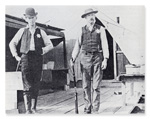
Remembered only as Dick and Andy, these two dangerous looking men were part of the "army" which held the Western Pacific positions during the fight for an outlet on San Francisco Bay. |
On
the night of January 5, 1906, the Western Pacific forces under Bartnett
struck.
With
200 workmen and 30 guards armed with carbines and sawed-off shotguns,
he used the dredging company as a front, and seizing the north training
wall, began feverishly to lay a rough track. Most of the guards
took up positions at the shore end of the U. S. training wall and
maintained them night and day. Laborers snatched their sleep in
shelter tents on the wave-washed rocks and the WP commissary department
fed them. Scows rushed more rails and ties across the Bay to the
end of the wall. Soon there was a mile of track on top of the rock
wall.
Of
course the Southern Pacific did not quietly accept this outrageous
trespassing on domains it had held undisputed for more than half
a century. Its legal department, fairly in convulsions, was whipping
out the necessary papers for immediate appeal to the law. This was
exactly what Bartnett had told Gould would happen and exactly what
they both desired. For the courts, as Bartnett had felt sure they
would, held that the Southern Pacific title to the waterfronts had
not progressed westward with the shoreline as the tidelands and
marshes had been filled in, but was valid only to the low tide line
of 1852. The S.P.'s "waterfront" therefore was by now well inland,
and the new marginal land surrounding it was the property of the
city. Years later, when the first WP passenger train reached Oakland,
Mayor Frank K. Mott in his speech of welcome said:
The
advent of the Western Pacific Railway is epochal. It is of peculiar
interest to Oakland, for this system's coming made it possible for
Oakland to recover control and possession of its magnificent waterfront.
This may well be placed first in the order of benefits which will
accrue to the city, as well as to the Bay region and the entire
state.
 CONSTRUCTION
WAS NOT EASY
CONSTRUCTION
WAS NOT EASY 
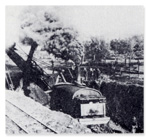
Steam shovel working in the cut just east of Oroville |
Construction
camps had been established by the contractors at points all along
the line under supervision of Company division engineers. Some were
accessible by rail and most of the others by wagon road. But, for
much of the distance through the rugged Feather River Canyon, not
even a foot path was handy to the route. Indeed the surveyors had
often hung suspended by cables over cliffs in order to set their
line stakes. So it was necessary first to blaze a trail and set
up small camps supplied by pack mules,then use these as bases for
building a wagon road over which supplies and equipment for building
the railroad could be hauled. It was slow, and often dangerous.
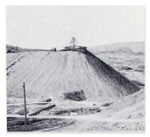
A "merry-go-round" was used in constructing large fills such as this one at milepost 59 |
At
Cromberg it was necessary to cross the swirling river on a jittery
rope bridge and here eleven men were lost working on the cliffs
or trying to cross the stream. They were tough men too, mostly lumberjacks
and hard-rock miners. Where Grizzly Creek drops into the Feather,
the field parties were forced to resort to rafts in order to by-pass
the sheer granite cliffs. Over at the Utah end crossing the salt
beds was a nightmare due to excessive temperature extremes and the
killing glare which often blinded men after a few hours work.
It
was difficult to hold men under such conditions while more pleasant
work was plentiful and turnover was terrific. Bogue actually had
detectives infiltrated through some of the gangs under the suspicion
that some outside agency must be stirring up trouble and inducing
the men to quit, but no evidence of this was ever found. On the
other hand the S.P. superintendent at Ogden wrote plaintively that
the Western Pacific was stealing all his track men and that it wasn't
very neighborly. T. J. Wyche, the WP engineer, replied that all
his assistants had positive instructions on this point and wouldn't
think of taking S.P. men. A few days later a Greek labor agent reported
that the next batch of track men he would deliver would have to
wait until they could get their time checks from the S.P.! Drunkenness
was a problem too, one which Bogue finally solved by buying up all
the saloon licenses handy to the job.

"Improved Harris Track-Layer" putting down rail near Hartwell (today's Quincy Junction) |
After
the depression of 1907 set in, there were plenty of men available - and
at lower wages. Had it not been for this unexpected break all of
the contractors would probably have gone bankrupt, since the work
proved considerably more costly than they had figured.
In
particular, the long tunnels at Spring Garden between the canyons
of the North and Middle Forks, Chilcoot at Beckwourth Pass, and
at Niles Canyon not far east of Oakland, ran into unexpected delays
and costs. Original plans had called for Western Pacific to be ready
for business by September 1, 1908, and when it became more and more
evident that this date could not be met, President Jeffery felt
mounting concern.

The magnitude of the Feather River Flood of March 1907 is shown in the construction photos of bridge No. 216.36, the Middle Fork crossing 7 1/2 miles east of Oroville. The first photo shows the bridge piers barely clearing the crest; the lower photo taken the following November shows the river at its normal flow. |
"It
is really a very serious situation to contemplate", he wrote Bogue
in January 1907, "and the key is the completion of the long tunnels.
The rest of the road we can build and get in running order, and
we can have our terminal facilities at San Francisco and Oakland
and our floating plant in San Francisco Bay all ready by or before
September 1 (1908).
It
was in March, 1907, when one of the worst storms in the history
of California struck and the resulting floods completely tied up
construction. Little damage was done to the half-finished Western
Pacific - in fact the storm effectively demonstrated the wisdom
of its location and Bogue wrote Jeffery that if they had been building
the 1 1/3 per cent grade originally chosen, their prospects would
have been grim. But it was impossible to deliver materials to the
job. Flood conditions were so bad that S.P. trains from Sacramento
to Oakland were operating by way of Fresno. With these and other
delays it was not surprising for Jeffery to write, "I long for the
day when we can have the railroad in operation and I can see the
fruition of my hopes and plans since 1892. Sixteen years is a long
time to contemplate, lay plans for and patiently work toward the
accomplishment of an enterprise; but this is what I have endured
to date, and must endure for fifteen or sixteen months more."
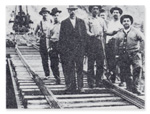
Foreman Leonardo di Tomasso prepares to drive the golden spike at Spanish Creek Bridge in 1909.
|

November 1, 1909 telegram from Arthur W. Keddie to Virgil Bogue congratulating him on the completion of the Feather River Route.
|
But
the rail laying which had started with the driving of the first
spike at 3rd and Union streets in Oakland on January 2, 1906, proceeded
eventually to the driving of the last.
On November 1, 1909, the
track gangs from east and west met on the steel bridge across Spanish
Creek near Keddie and foreman Leonardo di Tomasso drove the final
spike. In contrast to the gold spike ceremonies on the first overland
railway just forty years before, no decorated engines met head to
head before a cheering crowd; no magnums of champagne were broached.
The only spectators were a pair of local women and their little
girls.
 ENGINES
AND TERMINALS
ENGINES
AND TERMINALS 

WP 1909 built 2-8-0 Consolidation No. 34 |
Surprisingly
enough, President Jeffery had first favored equipping the Western
Pacific with small locomotives of the vintage of 1888. These had
given good service on the Rio Grande and were more economical than
the heavier engines it had since acquired. The engines Jeffery favored
were the D&RG class 106, a ten-wheel passenger locomotive with
a tractive effort of 18,000 pounds, and Class 113 for freight, a
consolidation with 25,000 pounds tractive effort.
Bogue
at first appeared to fall in with Jeffery's ideas, but raised one
doubt after another as to the wisdom of ordering these little old-fashioned
engines. Finally he secured blue prints of the motive power used
by the Southern Pacific on the Ogden Route and sent them on to Jeffery
in New York with his final comment on the 106 and 113 class: "To
place these locomotives on the road, hauling trains in competition
with the Southern Pacific, would probably prove to be a mistake."

WP 4-6-0 Passenger Ten-Wheeler No. 93 built in 1909
|
Jeffery
was convinced and comparable motive power was ordered: 65 consolidation
freight engines with 43,300 pounds tractive effort, 35 ten-wheel
passenger locomotives with a tractive effort of 29,100 pounds and
12 switchers. The first twenty freight engines were built by Baldwin,
the rest by the American Locomotive Company. They were a lot bigger
than the 1888 models although they would appear tiny in comparison
with those which would follow while they were still in service.
The work horses of the Western Pacific for several decades, they
were excellent machines.
Yards
and terminals for the new railroad had been most carefully designed.
Traffic estimates had been prepared from local statistics, S.P.
annual reports, etc., and diagrams prepared of expected east and
westbound tonnage of various classes. Train mile costs were estimated,
on the basis of 1,000-ton 30-car trains without helper service,
at $2.25 on the 1 per cent grade as against 1500-ton 45-car trains
with helpers at $3.58 plus 36 cents a mile to return light engines.
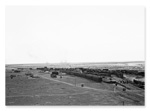
Wendover, Utah from the west, March 3, 1909 |
On
the basis of such studies Wendover had been selected as the first
subdivision point west of Salt Lake City although it was without
water. Shafter, 40 miles further east, had plenty of water, better
living conditions and was an interchange point with the Nevada Northern.
However, Wendover sat at the foot of 33 miles of 1 per cent grade
and the selection of Shafter as a subdivision point would have sacrificed
tonnage for speed in order to avoid overtime, as well as failure
to utilize the 100 miles of nearly level track east of Wendover
for maximum tonnage. Bogue estimated annual savings of $100,000
by picking Wendover against Shafter.
Each
division point had been made the subject of a similar careful study
as to location and design. At Oroville, the old gold workings governed
the layout and at Portola mountains and river were important factors.
Winnemucca was the dividing terminal between coal and oil burning
engines and here the Humboldt River influenced its site. Oakland,
in particular, had required painstaking analysis as the engine terminal
property was constricted and lay between two S.P. grade crossings.
Bogue and his assistants had done their work well.
Rates
of pay at the opening shed light on the passage of time. Locomotive
engineers drew $4.25 per ten- hour day; firemen, $2.75. Conductors
were paid by the month, $125 and no overtime. Brakemen got $86.25.
In the office, a chief clerk found eleven twenty-dollar gold pieces
and a five in his pay envelope; the stenographers $60 or even $75
if they were extra competent.
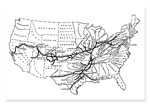
George Gould's rail system after completion of the Western Pacific in 1909
|
The
Western Pacific was now, operative but far from finished. From San
Francisco to Salt Lake City it stretched 927 miles, 150 miles longer
than the competitive route to Ogden; but against the latter's steep
grades, sharp curves, and heavy snows at a 7,017-foot elevation,
the new railroad had maintained Bogue's one per cent compensated
grade with a maximum curvature of 10°, and crossed the Sierra
at 5,002-foot elevation. On the basis of "adjusted mileage" in terms
of operating costs, it was rated shorter than the other road. Throughout
the line there were 41 steel bridges and 44 tunnels. Everything
had been designed and built according to the best contemporary standards
but there was much need for further ballasting and other finishing
touches.
Furthermore,
the Western Pacific was an integral part of a 13,708-mile nationwide
railway system that now reached from San Francisco to Baltimore,
with the exception of a short gap between Wheeling, West Virginia,
and Connellsville, Pennsylvania. It looked as if George Gould would
be successful with his dream of owning coast to coast rails, for
work on a missing link, the Wabash Pittsburgh Terminal, was being
rushed.
 A
DISCOURAGING START
A
DISCOURAGING START 
Through
freight service on the WP was inaugurated on December 1, 1909. Prior
to that there had been local freight service, largely between Salt
Lake City and Shafter for the Nevada Northern connection to the
flourishing mines of Ely. Traffic was disappointingly slim. The
daily lading wires to Jeffery were disheartening. During three days
in December, for example, 28,140 pounds of merchandise and one car
of lumber for Oakland was the total business received at San Francisco,
nothing whatever at Oakland, and similar results at other points.
Then came a small windfall, a solid fifty-car trainload of wire
and nails from the American Steel and Wire Company at Joliet, Illinois,
reached Salt Lake City on December 25 and brought Christmas cheer
to all connected with the new railway as it rolled west on WP rails.
The
cheerful mood did not last long. During the latter part of February,
1910, Old Man Winter hit California hard. Except for the Southern
Pacific route through Arizona the entire Pacific Slope was isolated
from communication with the East by landslides, snow banks and floods.
Night and day extra gangs wrestled with slides in the Feather River
Canyon and at Altamont Pass; there were four big washouts in the
desert between Gerlach and Winnemucca, and serious damage through
Palisade Canyon. And to make matters desperate along the whole railroad,
the waters of Great Salt Lake began to rise, ate away at the earth
fill, and seriously threatened eight miles of line carried on fill
and trestles. Consideration was even given to abandoning this track,
obtaining trackage rights over the San Pedro, Los Angeles and Salt
Lake route farther south, and building a ten-mile connection west
of the Lake. It was not until the latter part of May that operation
was returned to normal.
 AN
ENTHUSIASTIC WELCOME
AN
ENTHUSIASTIC WELCOME 
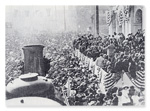
Seldon, if ever, has a train met a more enthusiastic welcome than Oakland put on for the first through passenger train on August 22, 1910 |
Passenger
service was not begun until August. On the 22nd of that month, the
fine new Oakland station, impressively corniced with eight immense
concrete eagles, saw an immense throng gather to greet the first
through train, a press special. Promptly on time at 4:15, amid the
shrieking of factory whistles from Berkeley to Hayward, engineer
Michael Boyle eased her through an Arch of Triumph at Broadway and
stopped before the depot.
The
trip had seen one amazing welcome after another. Crowds had turned
out all along the line, towns were decorated, salutes fired, parades
and brass bands were everywhere. Children decked out in their Sunday
Buster Brown suits or starched eyelet-embroidered dresses had waved
flags and tossed flower garlands, while their elders pressed local
gifts of grapes or watermelons upon the astounded passengers.
In
Quincy, 68-year old Arthur Keddie had almost wept as he spoke in
welcome from the court house steps.
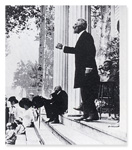
Arthur Keddie addressing a crowd from the steps of the Quincy courthouse
|
And
in Oakland itself, the crowd that surged in Third Street or lined
roof-tops and climbed telephone poles for a better view as the train
pulled up to the reviewing stand before the station, was as exuberant
as it was immense. A parade of welcome four miles long escorted
the passengers and railroad officers to a banquet at the Claremont
Country Club. In the flowery language of the day, the San Francisco
Call proclaimed: "The great heart of the State throbs at the triumphal
entry ... through canyons to the waters of the West, the Western
Pacific led its iron stallions down to drink."
George
Gould was not present to hear the nice words of welcome to his new
railroad. But soon thereafter his cushy business car Atalanta (white
tie and tails customary at dinner) came West on the rear end of
the Overland Express. Gould, with his pretty ex-actress wife and
children, was aboard on a tour of inspection. The multi-millionaire
railroad magnate made a hit with the "rails" when he took part in
an impromptu baseball game at Portola.
 THE
COST ESTIMATES WERE MUCH TOO LOW
THE
COST ESTIMATES WERE MUCH TOO LOW 
Gould
had not divided the financial responsibility for the Western Pacific
among his other railroads, but had placed it all squarely upon the
Denver and Rio Grande. By the terms of a mortgage arranged with
the Bowling Green Trust Company of New York in 1905, the Rio Grande
had underwritten $50 million in WP bonds, and in addition, had agreed
to advance any additional funds necessary to complete the line.
But
building and equipping the Western Pacific had cost almost twice
the $39 million estimate and the D&RG had been called on to
advance $16 million in cash. The correspondence of Edward T. Jeffery,
president of both companies, shows he was greatly worried at these
mounting figures and well he might have been for they were to pull
both railways into bankruptcy within a few years.
 WESTERN
PACIFIC GOES TO WORK
WESTERN
PACIFIC GOES TO WORK 
Gould
and Jeffery had, however, enabled the Western Pacific to embark
on its career with a top-flight staff of officers. C. H. Schlacks,
first vice-president, had 30 years of successful railroad experience
behind him; he had been general manager of the Colorado Midland
and later operating vice-president of the D&RG. Charles M. Levey,
second vice-president and general manager had been general superintendent
of the Burlington, general manager of its Missouri lines, and third
vice-president of the Northern Pacific. T. M. Schumacher, vice-president
in charge of traffic of both WP and D&RG, had been general traffic
manager of the El Paso and Southwestern, while Edward L. Lomax and
Harry M.Adams, passenger and freight traffic managers respectively,
were also capable men of wide experience. Such were officers at
the helm of the infant railroad. Two of them, Levey and Adams, were
destined to become its presidents.
But
not even supermen could have put the road immediately in the black.
The high cost of its construction had already nearly ruined the
Rio Grande's credit. This and the terms of the mortgage which forbade
any moneys to be spent on branches until the main line had been
completed, had prevented the construction of the numerous feeder
lines which had originally been contemplated. A worse deficiency
was the lack of online industries. In San Francisco the road opened
with only one industry spur, that of Dunham, Carrigan and Hayden.
Most of the plants and warehouses in Northern California were already
served by Southern Pacific and Santa Fe.

Brochure describing the joint route between the Gould System and the Orient |
However,
they did their best. Almost at once, they succeeded in signing advantageous
traffic agreements with the Santa Fe and the Pacific Coast Steamship
Company. They pioneered steam road interchange with the new electric
interurbans. A secret agreement, made March 26, 1906, by Jeffery
with Toyo Kisen Kaisha, now became operative and public knowledge.
By its terms this Japanese steamship company which had previously
interchanged with the Harriman lines would form a through route
with the Gould System. The first sailing direct from the Western
Pacific Mole took place February 8, 1911, when the Nippon Maru pulled
away with a load of cotton for the mills of Japan. Eastbound the
steamers brought in Oriental fabrics that rolled as million-dollar
silk specials on faster than passenger schedules. Fast fruit trains
made Chicago from Sacramento over the Gould System in 106 hours,
and coast-to-coast package merchandise cars ran over WP, Rio Grande,
Missouri Pacific, Wabash and Lackawanna.
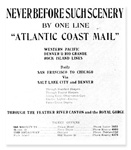
Advertisement for the Atlantic Coast Mail train in the San Francisco Bulletin, June 27, 1911
|
In
the passenger department Lomax was just as active in promoting the
beauties and opportunities for sport in the "Grand Canyon of the
Feather"; the luxury of the electrically lighted and fanned six-car
Atlantic Coast Mail. On - toes solicitation garnered special movements
for organizations ranging from the Bartenders Union to the International
Purity Congress. A Votes-for-Women Special paused at all stations
for observation platform speeches by the Suffragettes in the manner
later adopted by presidential candidates.
But
as the earnest efforts of both traffic branches fell far short of
profitable operation the Rio Grande became increasingly concerned
at the growing deficits. In 1911 it was forced to suspend dividends
on its preferred stock in order to meet the interest coupons on
the WP first mortgage bonds. By 1914 it was trying to get the terms
of the mortgage altered so as to eliminate this crushing burden.
Meeting with no success, its directors decided to default on the
coupons due March 1, 1915. As a result Western Pacific was forced
into receivership.
It
was a tragic decision for the Rio Grande and made in the belief
that under the contract it was liable only for the interest and
not the principal of the WP bonds. The Rio Grande could, at some
sacrifice, have met the interest for years, but its directors felt
that by precipitating foreclosure and the sale of Western Pacific
at auction, their liability would be ended. As it developed the
courts held otherwise.
The
Gould empire was crumbling. In the East the Wabash Pittsburgh Terminal
project had bankrupted the Wabash in similar fashion to the Rio
Grande's downfall. George Gould had been forced out of active control
of the great railway system. And, whatever the future of the Western
Pacific, it would now be on its own.
With
the San Francisco Exposition in 1915, slides closing the Panama
Canal, growing involvement of the United States in the European
War and, particularly, the results of its own development program,
WP traffic zoomed. But the property was sold at auction on the steps
of the Oakland station on June 28, 1916, by a Special Master in Chancery.
Three bank clerks, representatives of a bondholders' committee, bid
it in. It was quite a contrast to the gala triumph at the same spot
a short six years before.




























